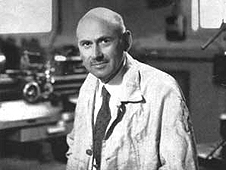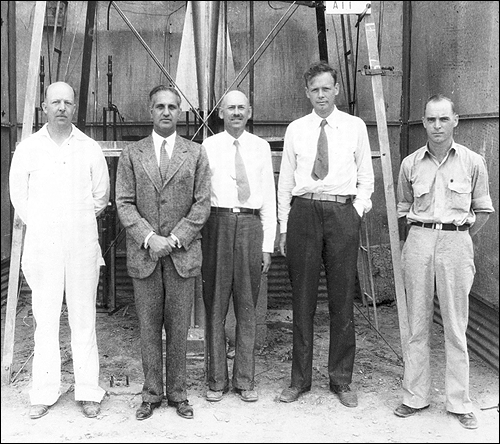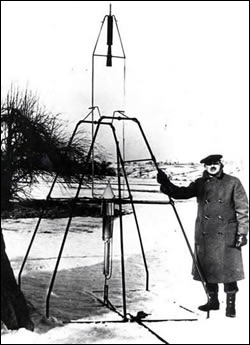
The Goddard Flight, Celestis’ tenth memorial spaceflight, was named in honor of Dr. Robert Hutchings Goddard, who is considered to be the father of modern rocket propulsion, and who conducted much of his pioneering research near Roswell, New Mexico. A physicist of great insight, Goddard also had a unique genius for invention. Given Celestis’ innovative use of rocket technology to launch cremated remains into space from Spaceport America, it is only fitting that we paid tribute to this aerospace pioneer and longtime New Mexico resident.
Born October 5, 1882 in Worcester, Massachusetts, Goddard developed his interest in space and astronomy at an early age, inspired in part by H.G. Wells’ sci-fi classic, War of the Worlds, and by his parents, who provided young Robert a telescope and otherwise encouraged him to pursue a scientific career. Goddard studied at Worcester Polytechnic Institute and Clark University, earning his Ph.D. in 1911. In 1914, Goddard received two U.S. patents. One was for a rocket using liquid fuel. The other was for a two or three stage rocket using solid fuel. Note that The Goddard Flight carried the ashes of Earth Rise service participants into space on board a solid fuel rocket.

At his own expense, Goddard began to make systematic studies about propulsion provided by various types of gunpowder. His classic document was a study he wrote in 1916 requesting funds from the Smithsonian Institution so that he could continue his research. This was later published along with his subsequent research in a famous January 1920 report to the Smithsonian Institution entitled “A Method of Reaching Extreme Altitudes.” In this treatise, Goddard detailed his search for methods of raising weather recording instruments higher than sounding balloons. In this search, he developed the mathematical theories of rocket propulsion.

Towards the end of his 1920 report, Goddard outlined the possibility of a rocket reaching the moon and exploding a load of flash powder there to mark its arrival. The press picked up the story and severely criticized Goddard. For example, in its January 13, 1920 issue, The New York Times tore into Goddard, arguing that he, “… does not know the relation of action to reaction, and of the need to have something better than a vacuum against which to react…. Of course he only seems to lack the knowledge ladled out daily in high schools.” The widespread public ridicule culminated in his being nicknamed “The Moon Man.”
By 1926, Goddard had constructed and successfully launched the first rocket using liquid fuel. Indeed, the flight of Goddard’s rocket on March 16, 1926, at Auburn, Massachusetts was as significant to history as that of the Wright brothers at Kitty Hawk.
Goddard’s greatest engineering contributions were made during his work in the 1920s and 1930s. He received a total of $10,000 from the Smithsonian by 1927, and through the personal efforts of famed American aviator Charles A. Lindbergh, he subsequently received financial support from the Daniel and Florence Guggenheim Foundation, which financed his research in New Mexico. Goddard spent a dozen years near Roswell, New Mexico with the support of the Guggenheim Foundation, further developing and testing his rocket designs.
While Goddard’s rocket work made little impression on American government officials of the 1920s and 1930s, German rocket scientists paid close attention: Goddard’s research largely anticipated in technical detail the later German V-2 missiles, including gyroscopic control, steering by means of vanes in the jet stream of the rocket motor, gimbal-steering, power-driven fuel pumps and other devices. Indeed, Goddard inspected several captured V-2’s in 1945, confirming that the Germans had used his designs. Goddard died later that same year from throat cancer.
Robert Goddard’s contributions to missilery and spaceflight would make a lengthy list. Here are some of Dr. Goddard’s firsts:
- Explored the practicality of using rocket propulsion to reach high altitudes and even the moon (1912)
- Proved that a rocket will work in a vacuum, that it needs no air to push against
- Developed and demonstrated the basic idea of the “bazooka” two days before the Armistice in 1918 at the Aberdeen Proving Ground in Maryland.
- Developed and launched a liquid fuel rocket (March 16, 1926, Auburn, Mass.)
- Launched a scientific payload in a rocket flight (1929, Auburn, Mass.)
- Used vanes in rocket motor blast for guidance (1932, New Mexico)
- Developed a gyro control apparatus for rocket flight (1932, New Mexico)
- Received U.S. patent in idea of multi-stage rocket (1914)
- Developed pumps suitable for rocket fuels
- Launched a rocket with a motor pivoted on gimbals under the influence of a gyro
NASA’s Goddard Space Flight Center in Greenbelt, Maryland, the Goddard Crater (located on the Moon’s eastern limb) and The Goddard Flight are all named in honor of this hero of space history.
Visit our new blog at www.Celestis.com/blog/
